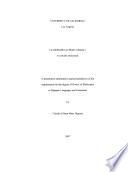Autores del Libro:
Resumen del Libro:

This dissertation connects Mateo Alemans Guzman de Alfarache (1599, 1604) to emblematic literature. Emblematic literature begins with the publication of Andrea Alciatos Emblematum liber in 1531. An emblem is a tripartite construction that combines a motto with a symbolic picture, followed by an epigram that clarifies the connection between the caption and the image. The impact of the Emblematum on sixteenth- and seventeenth-century art, literature, and architecture of the Spanish Empire was enormous. As Alciato himself anticipated, his book became a source of inspiration for all those who wanted to include emblems in their writings, et ualeat tactis scribere quisque notis. On account of this fashion other emblem books soon appeared. Conceived as guides to conduct, Spanish emblem books were part of the Counter-Reformation ideal of a directed society in Jose Antonio Maravalls words. Aleman participated in a culture of emblems that flourished in Spain during the Early Modern Period. Seville, his hometown, was regarded as a center where talented humanists and painters conceived elaborate programs of ephemeral architecture. Alemans friends were social reformers who wrote emblem books. Moreover, Aleman created the emblem of the spider and the snake that figures prominently in his portrait and which he insisted be printed on every work he ever published. My dissertation assesses the function of emblems in Guzman de Alfarache as an aspect of its overall moralizing intention. I argue that in specific passages Alemans use of emblems is ironical. He parodies theological and economic debates current at his time. I suggest that his irony constitutes an apology, a defense of work that instead of the noble ideal of otium cum dignitas favors productive labor for the benefit of society as a whole.
Formatos Disponibles: PDF / EPUB
Opciones de descarga:
Si deseas obtener una copia del libro puedes usar alguna de las siguientes opciones de descarga:
